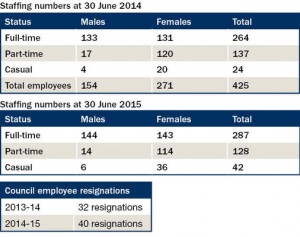
By ANEEKA SIMONIS
STAFF turnover at Cardinia Shire Council is double the average rate experienced by Victoria’s 78 other local governments.
Forty workers handed in their resignation in 2014-15, up eight on the 32 staff members who gave up council roles in 2013-14.
The council experienced a staff turnover rate of 21.32 per cent in 2014-15 – double the average rate recorded across all state councils which was 10.66 per cent.
Council spokesman Paul Dunlop, who is himself working his notice after resigning in late January, attributed high staff turnover rates to an internal review which was conducted during the 2014-15 reporting period.
The review cut loose staff who were fulfilling services “that were not legislative requirements” such as the council’s decision to stop running outside school hours care programs which were announced in April last year.
“The purpose of this review was to ensure that council operated as effectively and efficiently as possible and that residents received the best possible value,” Mr Dunlop said.
“The review also included some minor realignment of business units within the organisation to create better connections between the organisation and our community, with a customer focus.
“However, this did not necessarily affect staff turnover.”
Employment figures show the council has cut down on part-time employees, instead boosting its casual workforce by 75 per cent, an increase of 24 casual workers in 2013-14 to 42 in 2014-15.
Mr Dunlop listed a number of staff benefits available to workers at Cardinia Shire Council which was awarded international accreditation for its commitment to support and develop staff.
“Council is committed to ensuring staff have high levels of workplace satisfaction and this is demonstrated through staff benefits including an activity based working environment, supportive leave entitlements, an employee assistance program, a health and wellbeing program and flexible working arrangements when suitable,” he said.
“Council also undertakes a culture survey every two years to measure employee engagement and satisfaction.”
The council put on an additional 32 employees during the financial year ending 30 June 2015 bringing the workforce to 457 compared with 425 at the end of the 2014 financial year.
The council anticipates reporting lower rates of turnover in the coming financial year.





